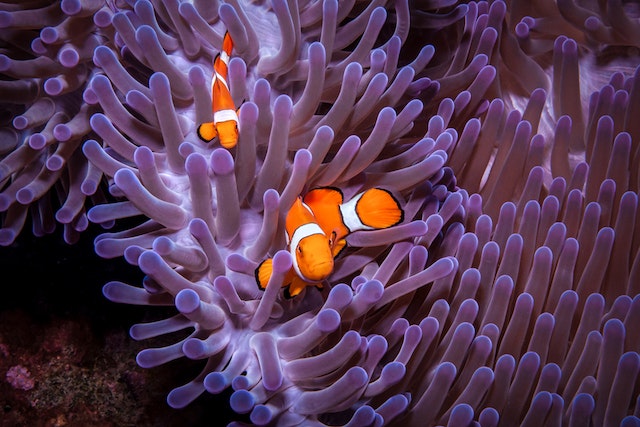
Are symbiotic relationships always beneficial to both parties? No, they aren’t. There are mutualistic, commensalistic, and parasitic symbiotic relationships.
The word symbiosis means “a close, prolonged association between two or more different biological species”. It originates with the Greek word symbiosis and means living together. We tend to think that a symbiotic relationship is beneficial to both parties, but that is not always the case. There are three different types of symbiotic relationships: mutualistic, commensalistic, and parasitic. Let’s look at each one in turn.
A mutualistic relationship is obviously one where both species benefit mutually. The two organisms work better as a pair than they could on their own. A common example is the anemone and the clownfish. Sea anemone are carnivores and they eat small fish, crabs, shrimp, and a number of other things. They have stinging capsules called nematocysts that they fire out when they feel the touch of their prey. These nematocysts have a spine that injects a neurotoxin into the anemone’s prey, paralyzing it, before the prey is drawn in to be eaten. Clownfish happily live among these anemone, without being stung. There are two reasons why they don’t get stung. Firstly, they produce a mucus that coats their skin and prevents the neurotoxin from working. Secondly, they do get stung, but this gives them antigens that stops the neurotoxin from working. How does this benefit both species? The clownfish benefit because they can live among the anemone, which protects them from other fish that would normally prey on them. The anemone benefit because the colorful clownfish attract other fish that the anemone can eat. Both species benefit, which is a mutualistic symbiotic relationship. Another example would be cattle egrets. These are birds that perch on cattle and eat the insects that rise up when the cattle graze. The birds have the advantage of finding more insects than if they hunted alone and the cattle have the advantage that the birds eat a lot of the insects that would bother them.
A commensalistic relationship is where one species lives with another species without abusing or harming the second species. The relationship is not mutual because the partnership is for the benefit of one of the species, not the other. The word commensalism comes from the Latin commensalis, which means “sharing from a table”. The word was first used in 1876 by a Belgian zoologist called Pierre-Joseph van Beneden. He also came up with the term mutualism as well.
An example of a commensalistic relationship is a bird making a nest in a tree. The tree provides shelter and a high, secure location for the bird, but the bird doesn’t give anything to the tree. However, the bird does not harm the tree in any way. The relationship is one sided, but there is no harm done to the other party. Remora sucker fish are another example. They have a large, flat sucker on the top of their head that they use to attach themselves to sharks. They float along with the shark until the shark starts to feed and then they detach themselves to feed on the pieces the shark doesn’t eat. The sharks give them a food source and they provide nothing to the shark, although they do not harm the shark. Another example are the animals, such as jackals and vultures that follow carnivores to eat their leftover prey. They get a food source without harming the carnivore.
Then, last, we have parasitic symbiotic relationships. These are relationships where one species gets a benefit at the expense of the other species. Parasitic relationships can often end in death, but they don’t have to. Tapeworms are a good example of a parasitic relationship. They attach themselves to the intestines of an animal and then feed on the partially digested food as it passes along. They deprive the animal of nutrients, but usually not enough to kill the animal. Fleas are another example of a parasitic relationship. They live on animals and feed off the animal’s blood. They get a warm and safe place to live as well. The bite marks itch and there is no benefit to the animal of having fleas. Many parasitic relationships harm the host but don’t ultimately kill them because this would be of no benefit to the parasite as they would have to find a new host. However, for some parasites, the object is to kill the host. Spider wasps are famous for laying their eggs in the abdomen of a spider. The egg becomes a larva and grows within the spider, consuming it. The larva is able to release hormones to control the spider so that it continues hunting for food and making webs. In the end, the larva kills the spider, The point of this parasitism is to have a food source. And this is what I learned today.
Photo by MaLia Evans: https://www.pexels.com/photo/couple-of-clownfish-12652728/
https://education.nationalgeographic.org/resource/symbiosis-art-living-together/
https://www.etymonline.com/word/symbiosis
https://en.wikipedia.org/wiki/Symbiosis
https://www.thoughtco.com/commensalism-definition-and-examples-4114713
https://a-z-animals.com/blog/what-do-sea-anemones-eat/
https://australian.museum/learn/animals/fishes/why-dont-anemonefishes-get-stung/
https://asknature.org/strategy/mucus-coat-protects-from-sea-anemone/
https://byjus.com/question-answer/what-are-5-examples-of-commensalism/
